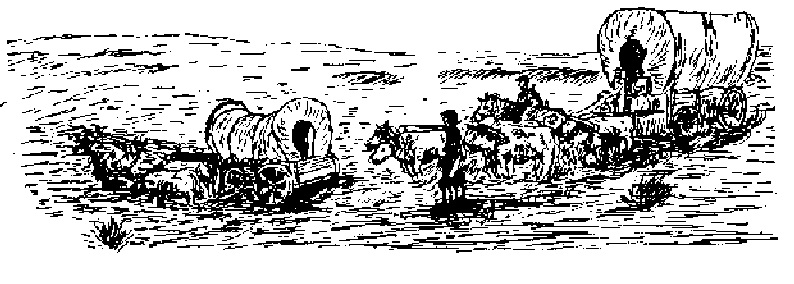sod shanties. Some of the sod shanties or rather sod houses were large enough for a good sized family. The one constructed by Christian Christianson was 16 x 24 and was the largest in western Murray County at that time. This house, like most of the others, was built of three foot strips of tough sod taken from a nearby slough. The sods were laid alternately so the walls were three feet thick. Saplings were cut from the stunted timber along the Beaver for rafters and the rafters were covered with willow brush. The brush was covered with coarse slough hay. Well packed yellow clay covered the hay and provided a roof which was almost rain and snow proof.
The corner posts of the house were Y shaped logs which came from Bear Lake timber. Yellow clay was used for chinking around the door and window frames. The boards for the door and window frames, and the tiny windows had been placed in the bottom of the wagon boxes when they started on the trail towards what was an almost unknown west. Root cellars were a real necessity. They were built in the same manner as the sod houses and some of them had entrances into them from the houses.
One of the necessities, which was easy to get and it was a blessing, was water. Abundant water could be secured on most farms at a depth of from 12 to 16 feet. Some of the early wells were used as they were dug, the top just covered with rough boards or small logs, but a large number of them was curbed with small rocks (nigger heads).
All the barns, or rather sheds, were made by piling straw over a skeleton of saplings and logs. The better ones were covered or thatched by a covering of the wiry slough hay.
Most of the settlers in Leeds township came from Fillmore County, nearly all of them coming from eastern Minnesota. The trip was a long one. Most of them had oxen and the oxen moved slowly with the well laden wagons and, to add to the slowness of the trip, all of them brought some live stock. The boys had the job of driving the stock behind the wagons and some of the lads walked the entire distance between here and Fillmore county. One little realizes what patient, resolute men and women these pioneers were, or the hardships and privations they endured. Here they were 80 miles
—26—
Not Searching for Gold but for a Place to Live

Early settlers on their way to new homes in Western Murray County
from a market, and the same distance from a doctor, coffee, sugar and flour. They were not too well blessed with worldly goods and they could not raise crops the first two years for the market. Trapping muskrats and mink kept the settlers supplied with the bare necessities. One family went without sugar or coffee for a whole year. They browned wheat and barley, and ground it in the coffee mill. When the barley and wheat ran out, they cut raw potatoes into small pieces, browned them on top of the stove and then ground them in the old coffee mill, which was the busiest and most important implement about the place.
During the early years of the settlement, the men were forced to leave the community and seek work. Some went to the harvest fields in the eastern part of the state; some went to the railroad tracks which were slowly pushing their way westward and some to the pineries for the winter. (This is what kept the families at home. The men must hold their claims.) Many of the men, carrying groceries, walked forty miles to get back to their little crude homes in Leeds in the spring; some even carried a sack of flour, for they were big, strong, sturdy men, these men of Leeds.
When the settlers had a little land broken up and were ready to raise crops, their hopes were high as they planted the newly turned sod. They looked forward to their first trip to market as the railroads were getting nearer. Their hopes were blasted, however, as hordes of grasshoppers swooped down out of the skies and lit on their crops. In a few hours their entire
—27—
Previous Page
Next Page
Table of Contents
Index of Names
Home

